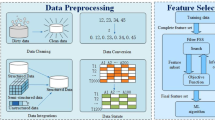Abstract
With the increasing popularity of social networks, malicious behaviors in social networks have brought severe security threats. To address the growing problem of malicious activities on social networks, researchers have proposed different detection and mitigation methods. However, the proposed approaches mainly focus on anomaly detection rather than anomaly prevention. In order to stop and reduce security threats in social networks, the anomalous behavior should be detected before it actually happens. Although some work exists, more effective and novel techniques need to be done toward anomaly prevention. In the paper, we explore the issue of anomaly prevention and creatively introduce trust to measure the similarity between users. Finally, a trust-based anomaly detection scheme is proposed, which can find collective anomaly before it brings greater security risks. The main contributions of our paper are: (1) constructing similar trust graph; (2) improving spectral clustering algorithm; (3) detecting collective anomalies in real time. In order to evaluate the effectiveness of our anomaly detection scheme, a series of test scenarios are developed. Three types of collaborative attacks are simulated on OMNeT++ platform. Simulation results show the good performance of the proposed anomaly detection scheme.













Similar content being viewed by others
References
Kaur R, Singh S (2016) A survey of data mining and social network analysis based anomaly detection techniques. Egypt Inform J 17:199–216
Jin L, Chen Y, Wang TY et al (2013) Understanding user behavior in online social networks: a survey. IEEE Commun Mag 51(9):144–150
Patil B, Bedi RK (2014) Survey on anomaly detection techniques in social networking. In Proceedings of the international journal of engineering research and technology, pp 1573–1576
Viswanath B, Bashir MA, Crovella M et al (2014) Towards detecting anomalous user behavior in online social networks. In: Proceedings of the 23rd USENIX security symposium (USENIX Security), pp 223–238
Xiao C, Freeman DM, Hwa T (2015) Detecting clusters of fake accounts in online social networks. In: Proceedings of the eighth ACM workshop on artificial intelligence and security, pp 91–101
Henderson K, Gallagher B, Li L et al (2011) It’s who you know: graph mining using recursive structural features. In: Proceedings of the 17th ACM SIGKDD international conference on knowledge discovery and data mining, pp 663–671
Hassanzadeh R, Nayak R, Stebila D (2012) Analyzing the effectiveness of graph metrics for anomaly detection in online social networks. In: Proceedings of the international conference on web information systems engineering, pp 624–630
Rezaei A, Kasirun ZM, Rohani VA et al (2013) Anomaly detection in online social networks using structure-based technique. In: Proceedings of the eighth international conference on internet technology and secured transactions, pp 619–622
Ying X, Wu X, Barbara D (2011) Spectrum based fraud detection in social networks. In: Proceedings of the IEEE 27th international conference on data engineering, pp 912–923
OMNET++. http://www.omnetpp.org
Vlasselaer VV, Akoglu L, Eliassi-Rad T et al (2015) Guilt-by-constellation: fraud detection by suspicious clique memberships. In: Proceedings of the 48 annual Hawaii international conference on system sciences, pp 918–927
Kirchner C (2011) Implementing social network analysis for fraud prevention. CGI Group Ind, Düsseldorf
Sensarma D, Sarma SS (2015) A survey on different graph based anomaly detection techniques. Indian J Sci Technol 8(31):1–7
Sherchan W, Nepal S, Paris C (2013) A survey of trust in social networks. ACM Comput Surv 45(4):1–33
Adali S, Escriva R, Goldberg MK (2010) Measuring behavioral trust in social networks. In: Proceedings of the IEEE international conference on intelligence and security informatics, pp 1–6
Sonja GK, Bitter S (2014) Trust in online social networks: a multifaceted perspective. Forum Soc Econ 45(1):48–68
Ketan A, Jay K (2017) Anomaly detection in online social network: a survey. In: Proceedings of the international conference on inventive communication and computational technologies, pp 456–459
Alam MAU, Roy N, Petruska M et al (2016) Smart-energy group anomaly based behavioral abnormality detection. In: Proceedings of the IEEE wireless health conference, pp 38–45
Briana A, LiEsa B, Rahmira R et al (2016) Behavior-based anomaly detection via immunity-inspired algorithms. In: Proceedings of the IEEE international conference on computer communications and networks, pp 1–6
Said A, Abbasi RA, Maqbool O et al (2018) CC-GA: a clustering coefficient based genetic algorithm for detecting communities in social networks. Appl Soft Comput 63:59–70
Jiang WJ, Wang GJ, Bhuiyan MZA et al (2016) Understanding graph-based trust evaluation in online social networks: methodologies and challenges. ACM Comput Surv 49(1):1–36
Chen SH, Wang GJ, Jia WJ (2016) Cluster-group based trusted computing for mobile social networks using implicit social behavioral graph. Future Gener Comput Syst 55:391–400
Jøsang A, Ismail R, Boyd C (2007) A survey of trust and reputation systems for online service provision. Decis Support Syst 43(2):618–644
Gong X, Yu T, Lee AJ (2013) Bounding trust under uncertain topology information in reputation-based trust systems. Lect Notes Comput Sci 7923:643–648
Yuan W, Guan D, Lee YK (2010) Improved trust-aware recommender system using small-worldness of trust networks. Knowl-Based Syst 23(3):232–238
Yoon KP, Hwang CL (1995) Multiple attribute decision making, an introduction. Sage University Papers (Series: Quantitative applications in the social sciences)
Freeman L (1977) A set of measures of centrality based upon betweenness. Sociometry 40:35–41
Xu K, Wang F, Gu L (2011) Network-aware behavior clustering of internet end hosts. In: Proceedings of the IEEE INFOCOM, pp 2078–2086
Xu K, Wang F (2011) Behavioral graph analysis of internet applications. In: Proceedings of the IEEE global telecommunications conference, pp 1–5
Douban. http://www.douban.com
Acknowledgements
The work in this paper has been supported by National Natural Science Foundation of China (Program No. 71501156) and China Postdoctoral Science Foundation (Program No. 2014M560796).
Author information
Authors and Affiliations
Corresponding author
Rights and permissions
About this article
Cite this article
Wu, X. A trust-based detection scheme to explore anomaly prevention in social networks. Knowl Inf Syst 60, 1565–1586 (2019). https://doi.org/10.1007/s10115-018-1276-9
Received:
Revised:
Accepted:
Published:
Issue Date:
DOI: https://doi.org/10.1007/s10115-018-1276-9




